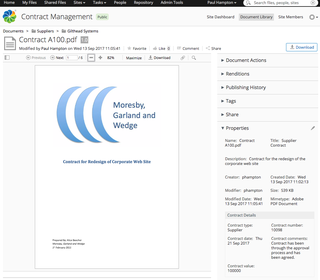The Organization for the Advancement of Structured Information Standards is a nonprofit consortium that works on the development, convergence, and adoption of projects - both open standards and open source - for Computer security, blockchain, Internet of things (IoT), emergency management, cloud computing, legal data exchange, energy, content technologies, and other areas.
WebDAV is a set of extensions to the Hypertext Transfer Protocol (HTTP), which allows user agents to collaboratively author contents directly in an HTTP web server by providing facilities for concurrency control and namespace operations, thus allowing Web to be viewed as a writeable, collaborative medium and not just a read-only medium. WebDAV is defined in RFC 4918 by a working group of the Internet Engineering Task Force (IETF).
The Open Document Format for Office Applications (ODF), also known as OpenDocument, standardized as ISO 26300, is an open file format for word processing documents, spreadsheets, presentations and graphics and using ZIP-compressed XML files. It was developed with the aim of providing an open, XML-based file format specification for office applications.
Web Services for Remote Portlets (WSRP) is an OASIS-approved network protocol standard designed for communications with remote portlets.
The Darwin Information Typing Architecture (DITA) specification defines a set of document types for authoring and organizing topic-oriented information, as well as a set of mechanisms for combining, extending, and constraining document types. It is an open standard that is defined and maintained by the OASIS DITA Technical Committee.
Web Services Discovery provides access to software systems over the Internet using standard protocols. In the most basic scenario there is a Web Service Provider that publishes a service and a Web Service Consumer that uses this service. Web Service Discovery is the process of finding suitable web services for a given task.
Enterprise content management (ECM) extends the concept of content management by adding a timeline for each content item and, possibly, enforcing processes for its creation, approval, and distribution. Systems using ECM generally provide a secure repository for managed items, analog or digital. They also include one methods for importing content to bring manage new items, and several presentation methods to make items available for use. Although ECM content may be protected by digital rights management (DRM), it is not required. ECM is distinguished from general content management by its cognizance of the processes and procedures of the enterprise for which it is created.

The Aviation Industry Computer-Based Training Committee (AICC) was an international association of technology-based training professionals that existed from 1988 to 2014. The AICC developed guidelines for aviation industry in the development, delivery, and evaluation of CBT, WBT, and related training technologies.

Alfresco Software is a collection of information management software products for Microsoft Windows and Unix-like operating systems developed by Alfresco Software Inc. using Java technology. The software, branded as a Digital Business Platform is principally a proprietary & a commercially licensed open source platform, supports open standards, and provides enterprise scale. There are also open source Community Editions available licensed under LGPLv3.
This is an overview of software support for the OpenDocument format, an open document file format for saving and exchanging editable office documents.
Content Repository API for Java (JCR) is a specification for a Java platform application programming interface (API) to access content repositories in a uniform manner. The content repositories are used in content management systems to keep the content data and also the metadata used in content management systems (CMS) such as versioning metadata. The specification was developed under the Java Community Process as JSR-170, and as JSR-283. The main Java package is javax.jcr.
The Advanced Message Queuing Protocol (AMQP) is an open standard application layer protocol for message-oriented middleware. The defining features of AMQP are message orientation, queuing, routing, reliability and security.
Nuxeo is a software company making an open source content management system.
The Microsoft Open Specification Promise is a promise by Microsoft, published in September 2006, to not assert its patents, in certain conditions, against implementations of a certain list of specifications.

An information card is a personal digital identity that people can use online, and the key component of an identity metasystem. Visually, each i-card has a card-shaped picture and a card name associated with it that enable people to organize their digital identities and to easily select one they want to use for any given interaction. The information card metaphor has been implemented by identity selectors like Windows CardSpace, DigitalMe or Higgins Identity Selector.
Content Assembly Mechanism (CAM) is an XML-based standard for creating and managing information exchanges that are interoperable and deterministic descriptions of machine-processable information content flows into and out of XML structures. CAM is a product of the OASIS Content Assembly Technical Committee.
WebSphere Portal is an enterprise software used to build and manage web portals. It provides access to web content and applications, while delivering personalized experiences for users.
Cloud Application Management for Platforms (CAMP) is a specification for managing applications in the context of a platform as a service (PaaS) system. CAMP is designed to address the needs of a high-level PaaS system; one in which the consumer provides application artifacts and specifies which provider-supplied services are required to realize these artifacts as an application. The details of the infrastructure used to support these services are hidden from the consumer by the provider of the PaaS system.
A common data model (CDM) can refer to any standardised data model which allows for data and information exchange between different applications and data sources. Common data models aim to standardise logical infrastructure so that related applications can "operate on and share the same data", and can be seen as a way to "organize data from many sources that are in different formats into a standard structure".



